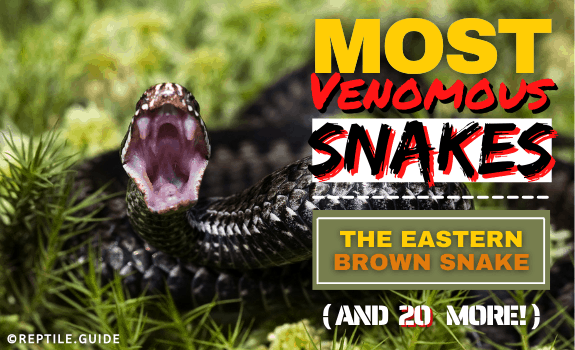Snakes; they’ve been hated, adored, revered, despised, and worshiped for centuries.
Some of the oldest recorded writings mention serpents, and they’ve left an indelible mark on our societies.
Some snakes leave a different kind of mark as well.
Around 8,000 people suffer from snake bites every year in the US alone!
There are far more harmless species than harmful ones.
Join us as we delve into the world of deadly species to learn about 21 of the most venomous snakes.
In This Article
In Short
- Puff Adders (Bitis arietans) are Africa’s deadliest snakes.
- Venom potency isn’t the only factor affecting a snake’s deadliness.
- Saw-Scaled Vipers (Echis carinatus) cause the most deaths worldwide.
- Venomous species aren’t the best pet snakes for beginners, but experienced owners can keep them.
- Eastern Diamondback Rattlesnakes (Crotalus adamanteus) cause the most deaths in the US every year.
- Hook-Nosed Sea Snakes (Enhydrina schistosa) and Inland Taipans (Oxyuranus microlepidotus) are the world’s most venomous snakes.
How Venom Works
Snake venom is, in many ways, similar to human medication. It comes in varying strengths, each snake produces different amounts, and they have various purposes.
In some snakes, the venom is a sedative and buys the snake time to constrict its prey or swallow it whole. In other species, the venom’s sole purpose is to kill.
There are three primary types of snake venom, and they are:
Cytotoxic Venom
Cytotoxic venom focuses on destroying cell walls. These snakes have one of the most painful types of snakebite, and many of the recorded deaths result from pain-induced shock.
Cytotoxins destroy cells, starting with the initial bite location and then spreading. The bite site shows necrosis (rotting of the flesh and cells) within 48 hours.
This necrosis may remain localized or spread, depending on the venom’s potency. Puff Adders and Mozambique Spitting Cobras both employ cytotoxins.
Neurotoxic Venom
Neurotoxic venom attacks the nervous system. This type of venom is one of the most dangerous since it attacks the system that keeps the brain alive.
These toxins attack nerve tissue and manifest as drowsiness, blindness, and paralysis. Death is prompt, as the toxin stops the lungs and heart.
Many cobras, as well as the Black Mamba, rely on neurotoxins to kill their prey.
Haemotoxic Venom
This venom attaches itself to the blood and prevents it from clotting.
These toxins break down the walls of veins and arteries. Symptoms include headaches and nausea, and death is the result of internal bleeding.
The Boomslang relies on this type of venom to take down prey.
Other Factors That Contribute to a Snake’s Deadliness
Venom potency isn’t the only factor affecting a snake’s deadliness.
The most venomous snake isn’t the deadliest by default, and the deadliest snake doesn’t have the most potent venom.
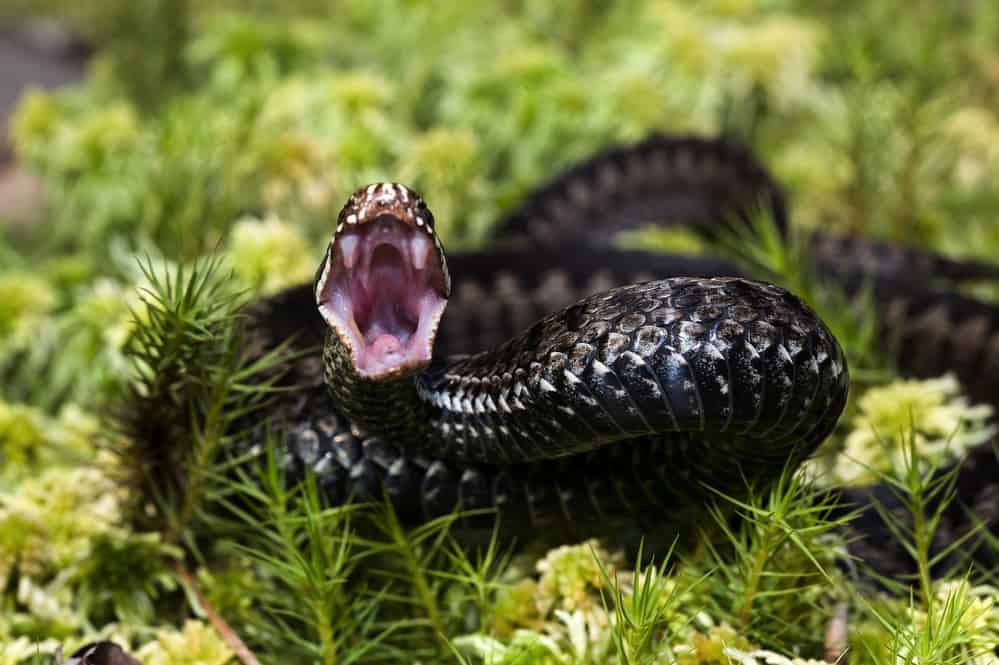
Speed
Many species of snake don’t live at high speed.
Pythons, some adders, and things like Garter Snakes amble along. Slow-moving species are less likely to inflict damage than high-speed predators.
Many sit-and-wait predators can move at reckless speeds to strike anything that comes within their grasp.
This category includes species like the Desert Death Adder (Acanthophis pyrrhus).
Other snakes, like the Black Mamba, rely on their speed to catch prey.
Willingness to Strike
Not every species of snake is willing to strike.
Most snakes want you to leave them alone and prefer fleeing to biting. Many cobras will raise their hoods and mock-strike to warn you to leave them alone.
Some snakes will strike with next to no provocation. These grumpy snakes include the Black Mamba and the Saw-Scaled Viper.
Many ambush predators lie in places that obscure their natural vision, so they rely on heat signatures. As a result, they’ll strike at any warm-blooded creature that enters the vicinity.
Camouflage
Despite what people think, snakes aren’t at the top of the food chain. Crows, weasels, badgers, eagles, and monkeys are all happy to eat our scaled friends.
As a result, many snakes employ camouflage to help them stay out of sight. While this ability to disappear is of great use to the snake, it’s an unfortunate danger for humans.
Like the Gaboon Viper (Bitis gabonicus), many snake species disguise themselves on the floor or in bushes while waiting for prey.
Many bites happen when people step on the snake or encounter it in a bush or tree.
Proximity to People
Most snakes tend to avoid places where humans thrive, but some don’t.
Attracted by the heat and food (like rats and mice) accompanying human homes, these species live in villages and towns.
For the most part, the species that like human habitations are pretty harmless.
Many villages in South America and Asia invite harmless pythons to cohabit with them. The snakes help control the rodents, which is a benefit to the villagers.
Some deadlier species can learn that humans mean ready food sources.
In Southern Africa, it’s not uncommon to find Mozambique Spitting Cobras in cars.
The snakes enter through cracked windows or from below the car, trying to take advantage of the engine’s heat production.
Fang Placement
There are two primary types of fang placement in snakes, and they can make a huge difference when you get bitten.
Front-fanged snakes have a more efficient venom delivery system. Their fangs are two sharp, hollow tubes into which the venom flows.
These fangs act as needles and deliver venom straight into the host.
In back-fanged species, the venom runs onto, rather than through, the fangs. This system is less effective and lessens the chances of severe toxicity.
#1 – Hook-Nosed Sea Snake (Enhydrina schistosa)
Origin: Coastlines of the Indian Ocean and the Arabian Sea
Habitat: Mangrove forests and other coastline vegetation / in the ocean near the shore
Level of Aggression: Extreme
Venom Potency (required mg/kg of body weight to kill): 0.02 mg
Conservation Status: Least concern
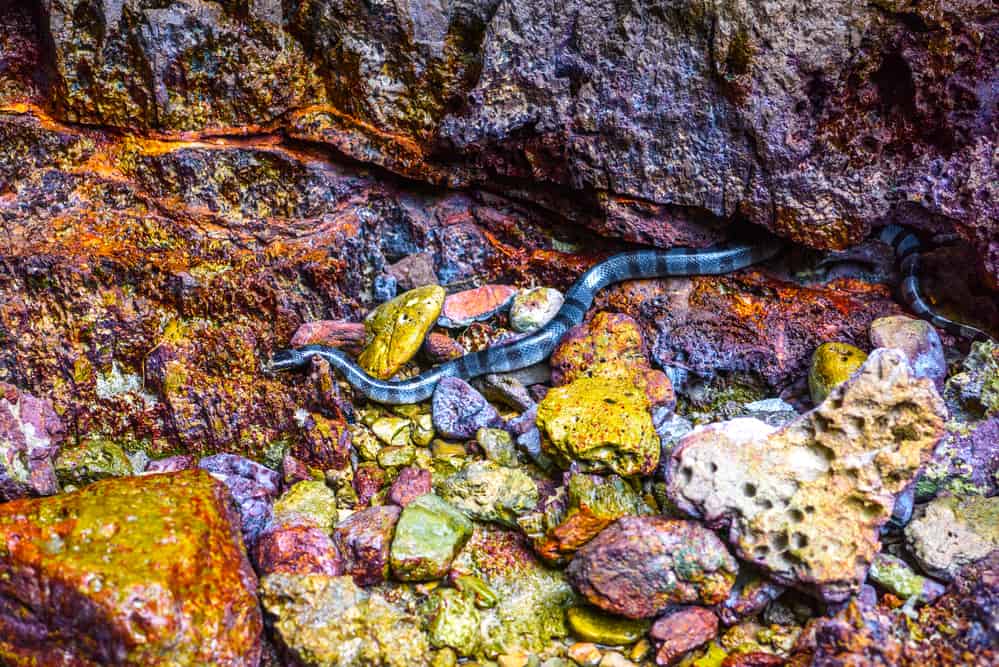
The Hook-Nosed Sea Snake is one of the most venomous snakes in the world. It is also one of the most aggressive species, and even herpetologists are reluctant to go near them.
Their saving grace, and those of humans, is that this species isn’t common on dry land. Sea snakes spend most of their time in the shallow areas (up to 100 m deep) of the ocean.
People encounter these snakes when they wash up on beaches. Sea snakes subsist on fish and don’t need to hunt on land. They drink fresh water from the ocean’s surface.
#2 – Russell’s Viper (Vipera russelii)
Origin: India, Sri Lanka, Bangladesh, Nepal, and Pakistan
Habitat: Plains, lowlands, and secondary growth areas
Level of Aggression: High
Venom Potency (mg/kg): 0.03 mg
Conservation Status: Least concern
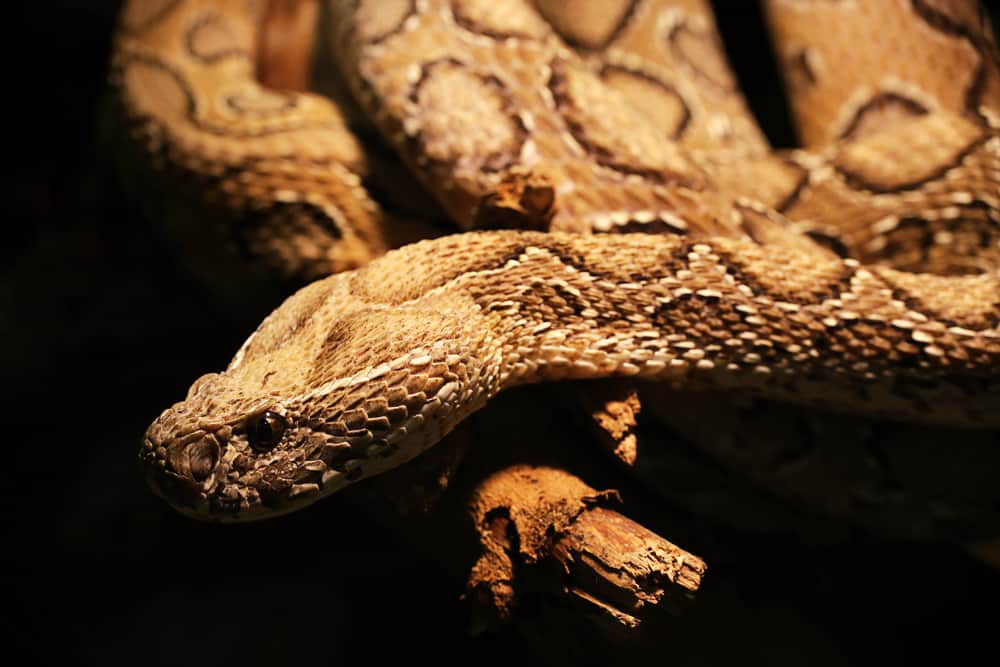
Russell’s Vipers’ primary range is in India, where the snakes are numerous in some areas and rare in others.
It’s one of the four largest species in the region, growing to around 5.5 feet.
This species has a potent venom and an aggressive nature which make it threatening to humans.
Compounding this issue is that these snakes are attracted to human habitations by the rodents that live there.
This species hunts at night, and people rarely encounter it during daylight hours.
#3 – Inland Taipan (Oxyuranus microlepidotus)
Origin: Central and Eastern Australia
Habitat: The black-soil plains
Level of Aggression: Medium
Venom Potency (mg/kg): 0.03 mg
Conservation Status: Least Concern
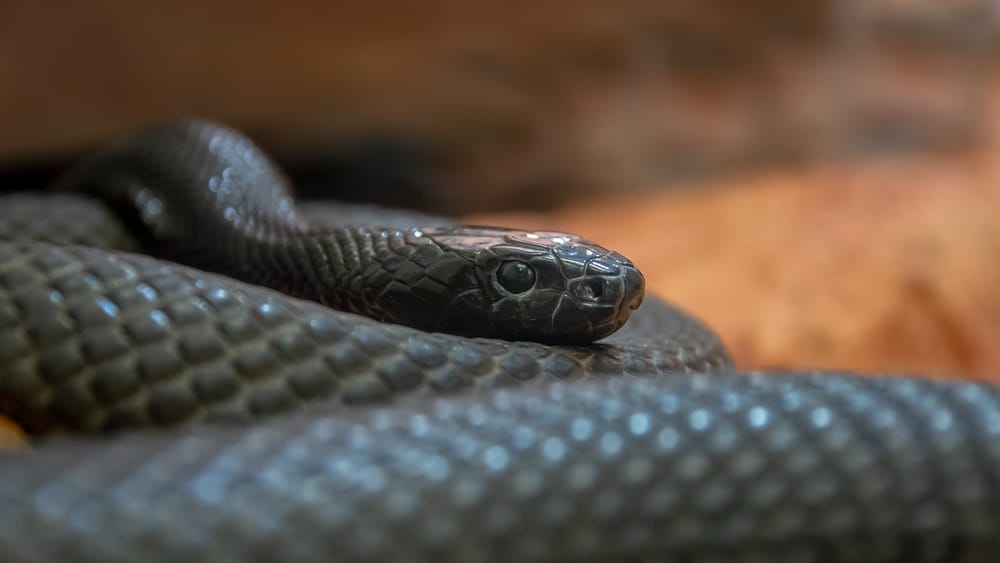
The Inland Taipan has a small distribution spanning the black-soil plains of Central Australia.
There are reports of a more expansive range, but the current proven range is small.
Its small range, combined with its docile nature, means that this species rarely bites humans.
It has the most potent venom of any Australian snake, and some argue that it’s the most venomous in the world.
This species thrives on rodents, and human settlements within its range may attract it. This snake prefers fleeing to confrontation.
#4 – Dubois’s Reef Sea Snake (Aipysurus duboisii)
Origin: Coastlines of the Arafura Sea, Coral Sea, Timor Sea, and the Indian Ocean
Habitat: Coastal forest and vegetation / the ocean near the coastline
Level of Aggression: Medium
Venom Potency (mg/kg): 0.04 mg
Conservation Status: Least concern
Despite its high toxicity, the Dubois’s Reef Sea Snake is an inconspicuous animal. This species prefers the ocean and shallow reefs to dry land.
Except by anglers and divers, this species is rarely seen and not well-known. As with most sea snakes, this snake feeds on fish and drinks rainwater.
Bite reports are rare and, thanks to their small fangs (2 mm), the strikes are quite painless. Despite the lack of pain caused by this species’ bite, the venom can be fatal.
This snake has a reputation for being irritable and may strike if disturbed.
#5 – Eastern Brown Snake (Pseudechis textilis)
Origin: Eastern and Central Australia
Habitat: Forest, woodlands, and grasslands
Level of Aggression: High
Venom Potency (mg/kg): 0.05 mg
Conservation Status: Least concern
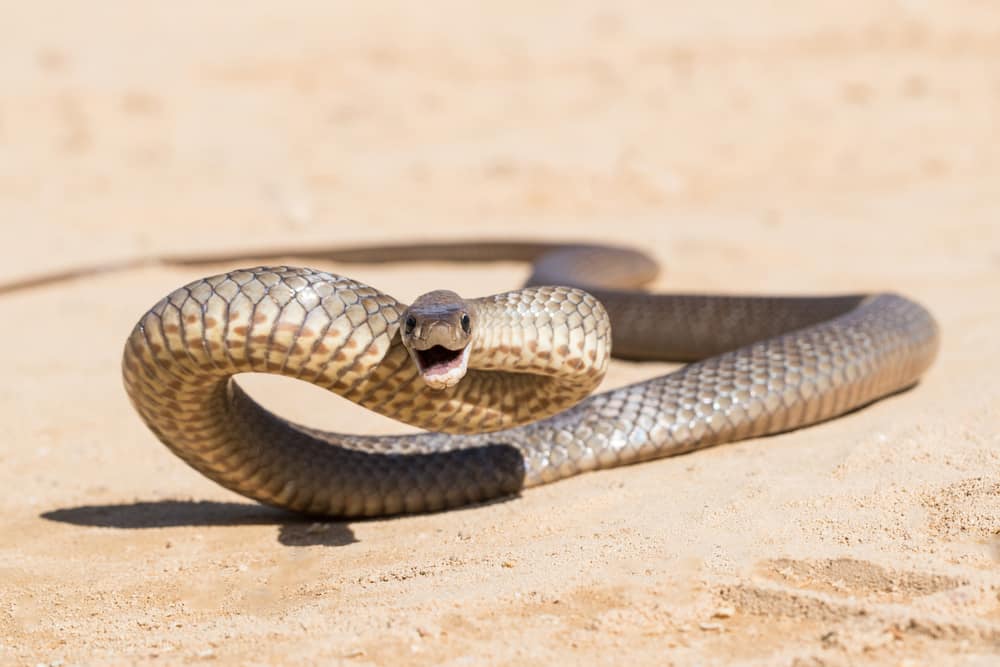
The Inland Taipan may be Australia’s most venomous species, but the Eastern Brown Snake is the deadliest. It reaches about seven feet in length.
This species is aggressive and frequents villages, towns, and settlements to eat rodents.
You can often find these snakes near freshwater sources, and humans tend to visit the same clean water.
This snake’s temperament, venom potency, and attraction to humans mean that it’s one of the Australian species with the most bite reports.
#6 – Black Mamba (Dendroaspis polylepis)
Origin: Sub-Saharan Africa
Habitat: Woodlands, scrub, and semi-arid savannas
Level of Aggression: Extreme
Venom Potency (mg/kg): 0.05 mg
Conservation Status: Least concern
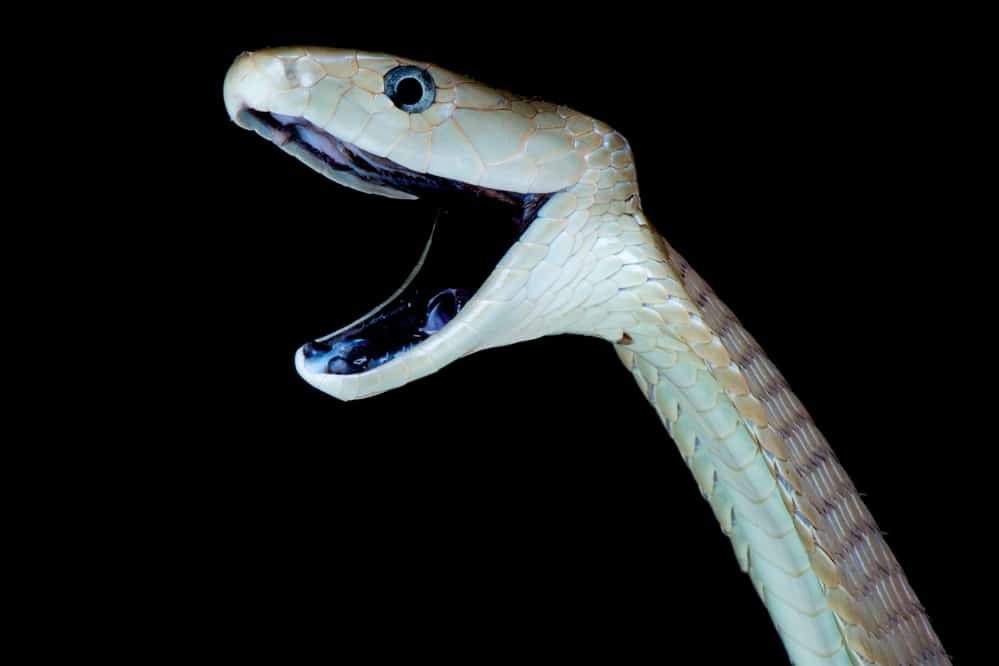
The Black Mamba is a snake with a bad attitude. Most snakes prefer to escape conflict, but this species doesn’t care.
If you’re lucky, you’ll get a loud warning hiss that displays the snake’s black mouth lining.
The intense black coloration and hissing serve as a warning that this species is armed and dangerous.
The longest Black Mamba on record was about 14 feet long, though the species averages around seven.
This bad-tempered and aggressive species blends into its grassland habitat and strikes at lightning speed.
By all accounts, you’d do well to avoid this grumpy, venomous predator.
#7 – Tiger Rattlesnake (Crotalus tigris)
Origin: Southwestern US and Northwestern Mexico
Habitat: Deserts and grassland
Level of Aggression: High
Venom Potency (mg/kg): 0.06 mg
Conservation Status: Least concern
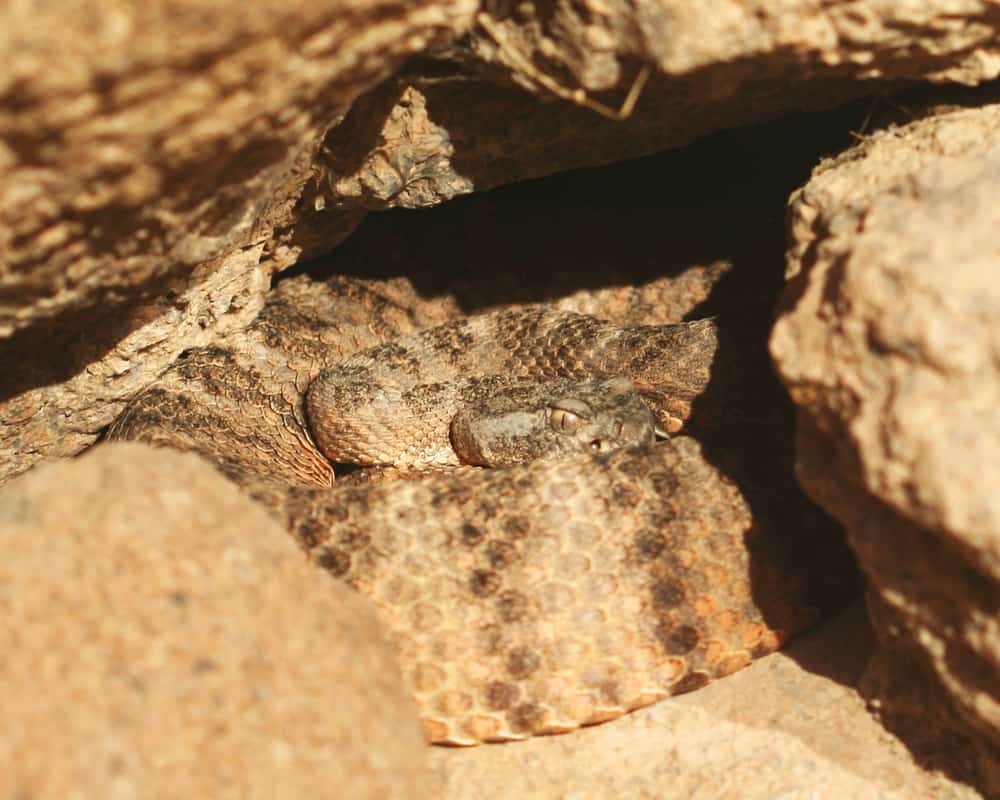
The Tiger Rattlesnake is a medium-sized pit-viper that reaches around three feet in length.
Most of the bites occur in farmland or similar areas when someone stumbles into the snake. This species prefers rocky areas where it lies in wait for rodents or other small animals.
The Tiger Rattlesnake has strong venom and won’t hesitate to bite.
If you plan on visiting “wild” areas in the Southwestern US or the Northwest of Mexico, keep your eyes open.
#8 – Boomslang (Dispholidus typus)
Origin: Sub-Saharan Africa
Habitat: Savannas and lowland forests
Level of Aggression: Low
Venom Potency (mg/kg): 0.07 mg
Conservation Status: Least concern
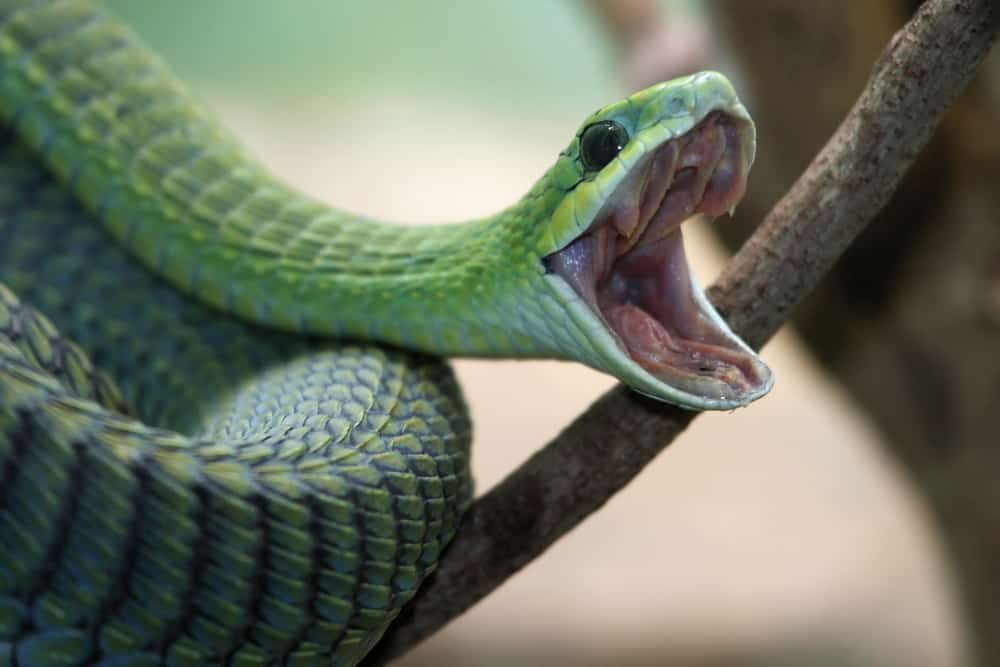
The name Boomslang comes from an Afrikaans term that means “tree snake.” The name is apt, as this species spends most of its time moving from tree to tree and feeding on lizards.
While this species has toxic venom, it’s anything but aggressive. These snakes are shy, docile creatures that prefer to go unnoticed.
While the Boomslang can move at high speeds, it uses that skill to flee.
#9 – Yellow-Bellied Sea Snake (Pelamis platurus)
Origin: Shorelines of the Indian and Pacific Oceans
Habitat: Coastal vegetation and water near the shore
Level of Aggression: Medium-High
Venom Potency (mg/kg): 0.07 mg
Conservation Status: Least concern
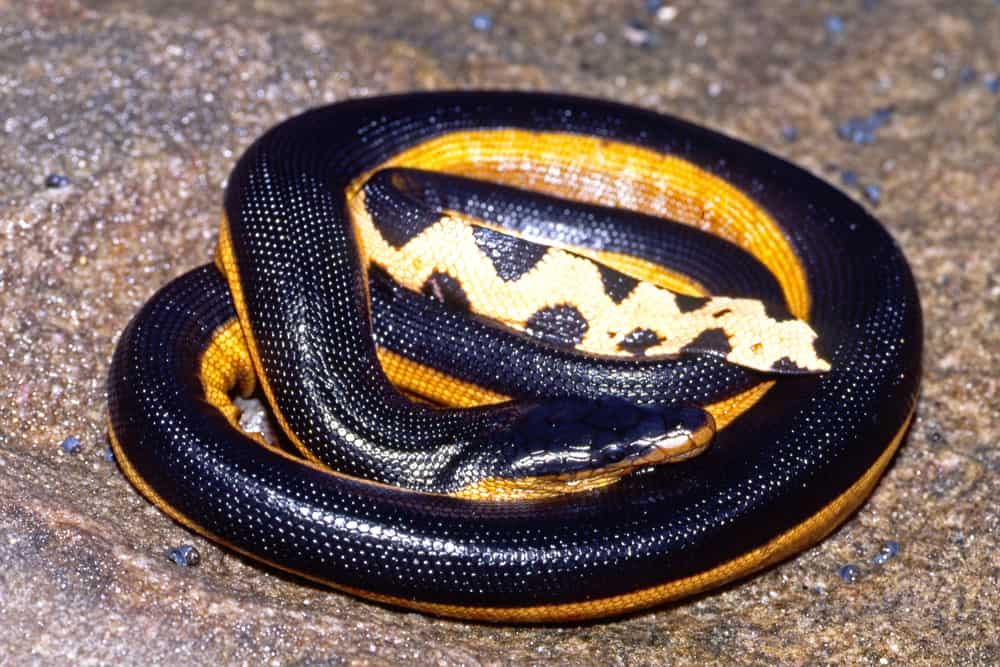
The Yellow-Bellied Sea Snake is one of the most-encountered sea snake species and often washes up on the coast.
This species isn’t known to be aggressive, and bites are uncommon. This snake can strike when caught in fishing nets.
This snake is small and only reaches about 35 inches.
#10 – Common Indian Krait (Bungarus caeruleus)
Origin: Indian Subcontinent
Habitat: Diverse; visits villages
Level of Aggression: High
Venom Potency (mg/kg): 0.09 mg
Conservation Status: Least concern
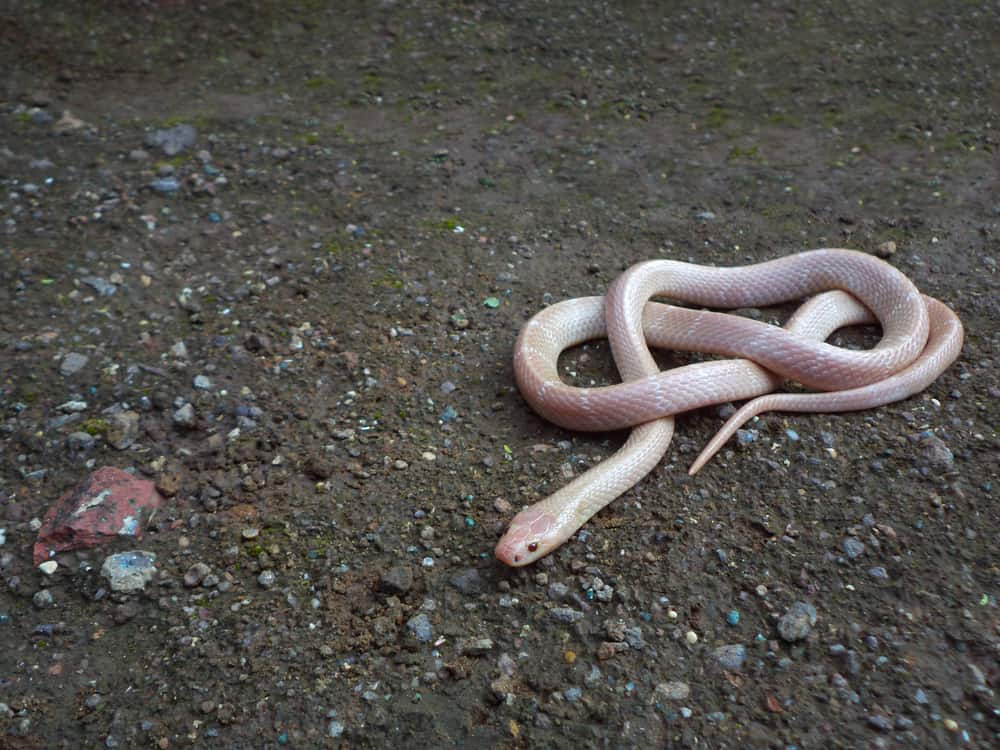
The Common Indian Krait, or Blue Krait, is an aggressive and plentiful species from the Indian subcontinent.
This snake’s aggression, combined with its love of the rodents found near human settlements, put it at odds with humans.
Bite reports are common, but deaths aren’t, and most victims recover.
This species reaches around three feet in length.
#11 The Deadliest Snake in the World – Saw-Scaled Viper (Echis carinatus)
Origin: Distribution ranges most of Asia
Habitat: Diverse; prefers rocky terrain
Level of Aggression: Extreme
Venom Potency (mg/kg): 0.24
Conservation Status: Least concern
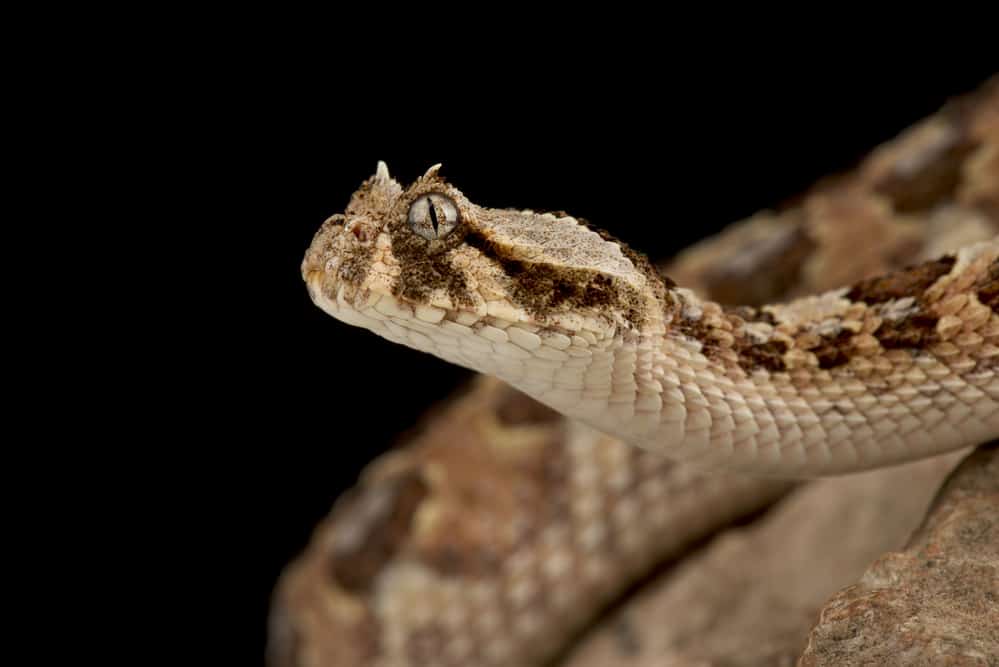
The Saw-Scaled Viper is a small species that only reaches about 31 inches in length. It has a huge distribution that covers most of Asia.
Despite its small size, this snake is deadly. It has an extreme temper and will bite with little provocation.
Scientists believe that the Saw-Scaled Viper is responsible for most of the 81,000–138,000 snakebite-related deaths every year.
#12 The Deadliest Snake in the US – Eastern Diamondback Rattlesnake (Crotalus adamanteus)
Origin: Southeastern United States
Habitat: Diverse; forests and marshes
Level of Aggression: Medium
Venom Potency (mg/kg): 1.2 mg
Conservation Status: Least concern
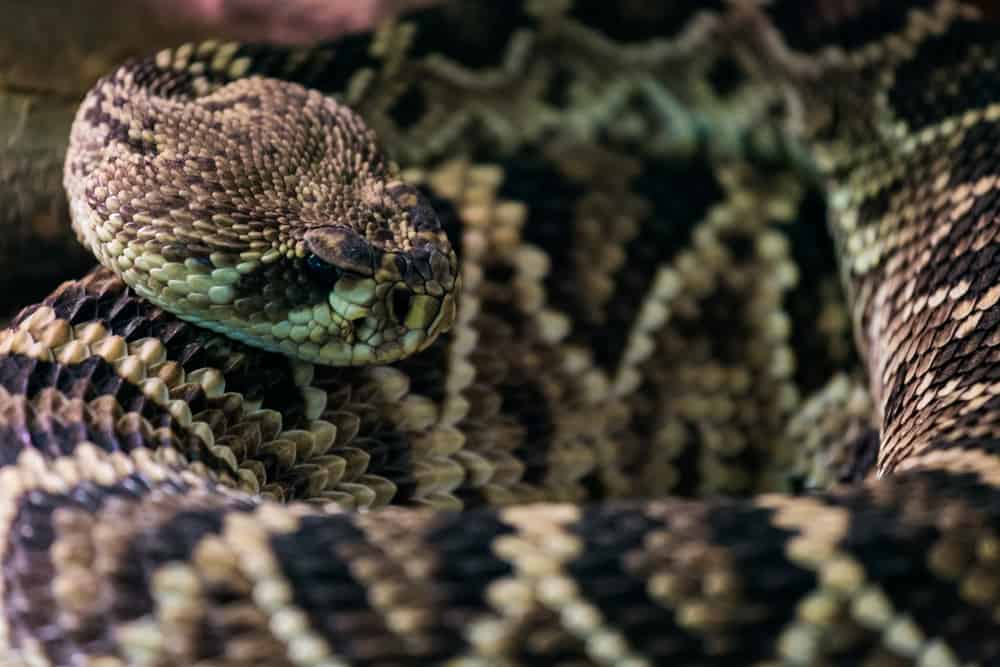
As with many of the deadliest snakes, the Eastern Diamondback Rattlesnake is a sit-and-wait predator.
It lies in wait in areas where prey items are likely to pass, which also puts it in the path of humans.
This species causes most snake-related deaths in the United States every year, and people should regard it with caution.
This species will rattle its tail before striking, so you’ll have a warning.
#13 The Deadliest Snake in Africa – Puff Adder (Bitis arietans)
Origin: Africa (excluding deserts and rainforests), Morocco, and Arabia
Habitat: Diverse; prefers rocky grassland; avoids deserts and rainforests
Level of Aggression: Extreme
Venom Potency (mg/kg): 0.14 mg
Conservation Status: Least concern
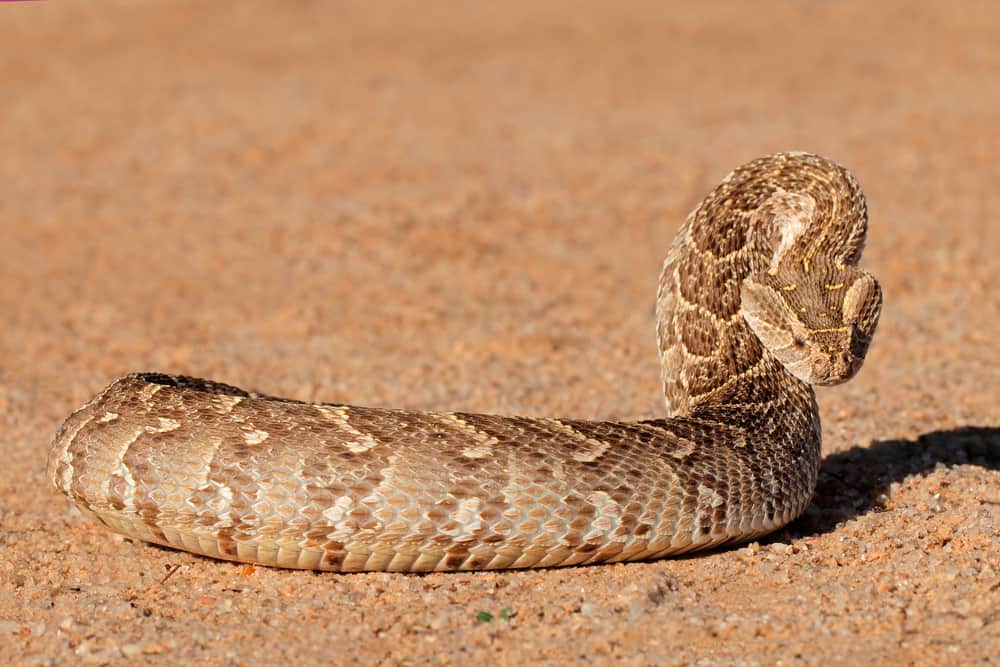
The Puff Adder doesn’t have the strongest venom of any African snake, but it’s the deadliest. This species is aggressive and refuses to make way for larger animals.
Puff Adders eat rodents and small lizards, so they’re attracted to the areas around human habitations.
Combined with their aggressive nature and wide distribution, these factors make this species deadly.
Puff Adders are responsible for most of the snake-related deaths caused in Africa every year, despite sharing territories with more venomous species.
#14 The Most Venomous Snake in Europe – Common European Viper (Vipera berus)
Origin: Continental Europe
Habitat: Diverse
Level of Aggression: Low
Venom Potency (mg/kg): 0.11
Conservation Status: Not assessed
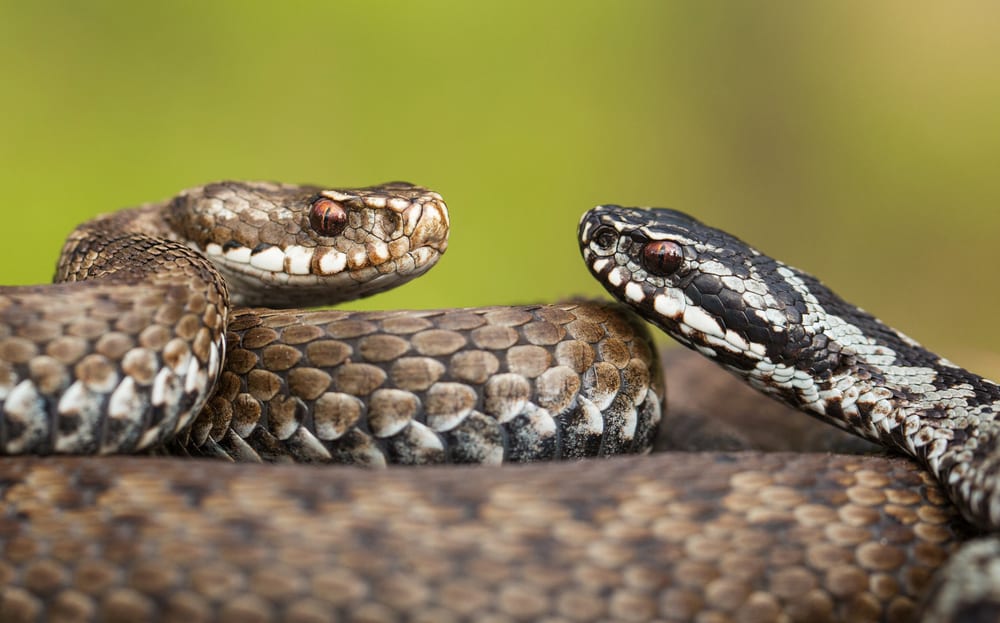
The Common European Viper is a small (up to 35 inches), non-aggressive species.
Its distribution ranges across most of continental Europe, and it’s a common sight in many areas.
This species is calm and prefers flight to fight. It may be the most venomous European species, but bites are uncommon.
Its venom is potent, though, so bites can be life-threatening. Thanks to the available antivenins, deaths are rare in modern times.
While few people would consider these the best reptiles to keep as pets, some people specialize in keeping vipers and adders.
These snakes have beautiful scales, speed, and aren’t too large—who wouldn’t be tempted to keep one?
#15 South America’s Most Lethal Snake – Fer-de-Lance (Bothrops asper)
Origin: Southern Mexico and Northern South America
Habitat: Moist habitats at low altitudes
Level of Aggression: Medium-High
Venom Potency (mg/kg): 1.1 mg
Conservation Status: Least concern
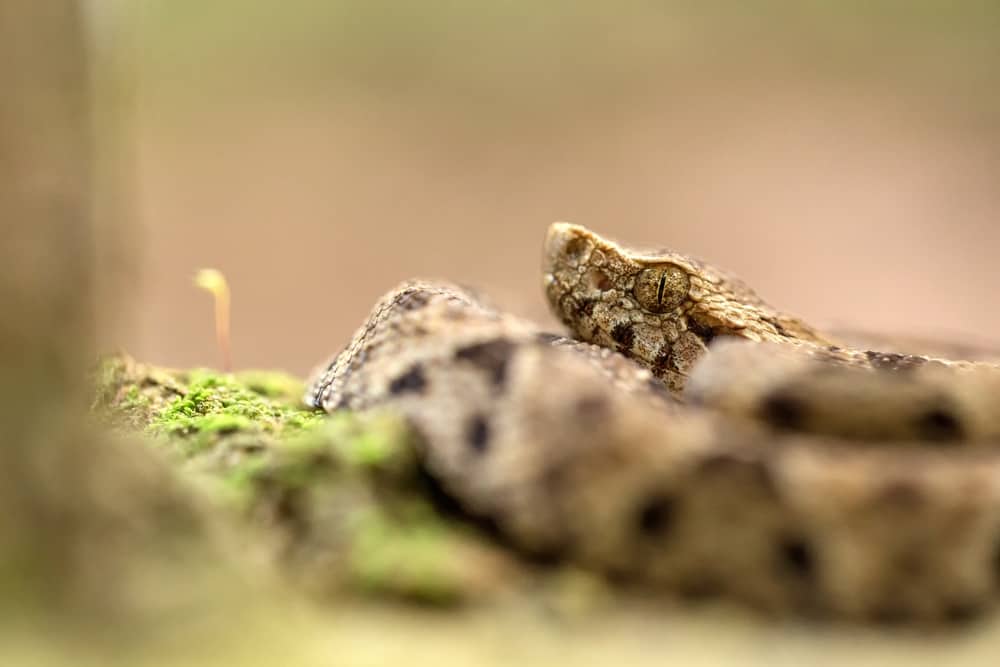
The Fer-De-Lance is a semi-aggressive South American species that frequents houses. These snakes can reach lengths near six feet.
This species is less toxic than the top ten, but it can kill you. It’s easy to encounter the Fer-de-Lance, a fast-moving sit-and-wait predator, and bites are common.
This snake is also known as the Lancehead Pit-Viper and the Barba Amarilla.
#16 The World’s Largest Venomous Snake – King Cobra (Ophiophagus hannah)
Origin: South and Southeast Asia
Habitat: Near fresh water in forests and thickets
Level of Aggression: Low-Medium
Venom Potency (mg/kg): 0.9 mg
Conservation Status: Vulnerable

The King Cobra is the king of the snake kingdom and rules by terror.
This beautiful species is the largest venomous snake and reaches lengths of about 18 feet. Most of its diet consists of other snakes, though it also eats frogs and lizards.
This species is a bit aggressive, dwells near water, and avoids larger animals.
#17 The Master of Camouflage – Gaboon Viper (Bitis gabonica)
Origin: Central and Western Africa, parts of Southeastern Africa
Habitat: Rainforest and woodland
Level of Aggression: Low
Venom Potency (mg/kg): 0.14 mg
Conservation Status: Not assessed
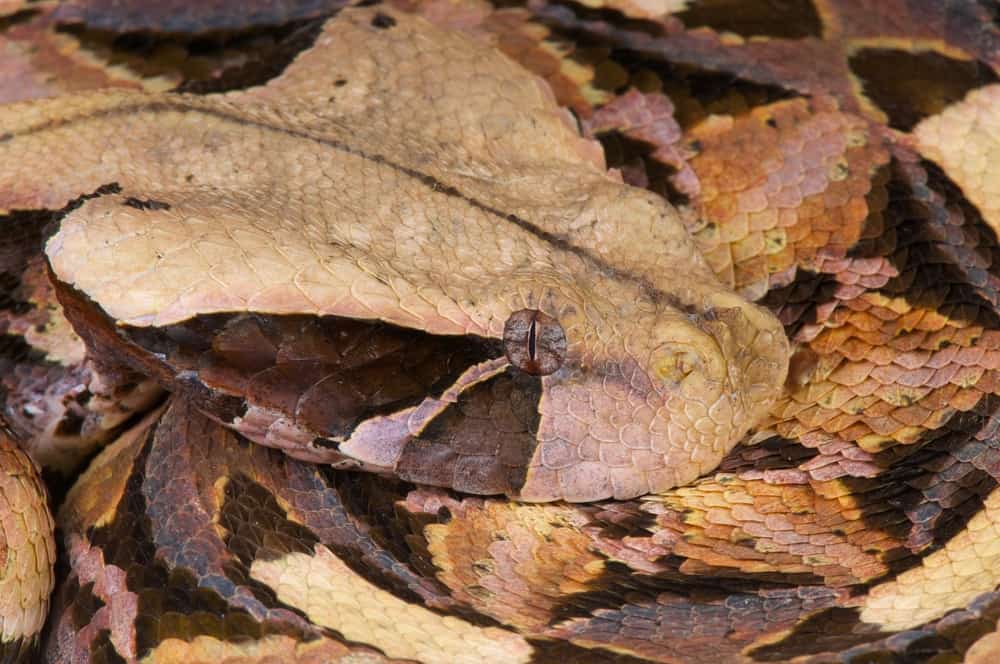
The Gaboon Viper has a deadly combination of potent venom and camouflage.
This species camouflages itself in the leaf litter of forests and overgrown areas. It relies on its prey not seeing it and strikes at high speed.
This sit-and-wait hunting technique can result in a stepped-on snake and a bitten human.
Human deaths are rare because of the snake’s reclusive nature and slow movement (when not striking).
According to the LA Zoo, this snake has the highest venom yield of any species.
#18 The Archer of the Snake World – Mozambique Spitting Cobra (Naja mossambica)
Origin: Eastern parts of Tropical and Subtropical Africa
Habitat: Habitats near freshwater
Level of Aggression: High
Venom Potency (mg/kg): 1.82 mg
Conservation Status: Least concern
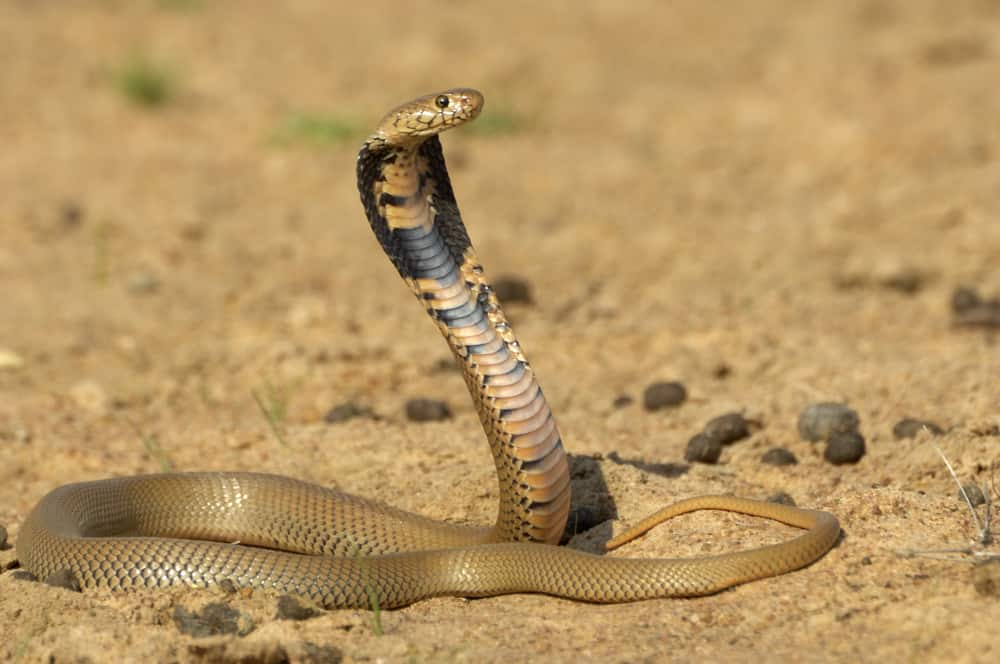
The Mozambique Spitting Cobra may not have the most potent venom of any species, but it has some other tricks up its sleeve.
When threatened, these snakes will rear up, make a hood, and spit venom.
They can spray their venom more than nine feet. If the toxin hits your eyes, it can cause permanent blindness.
This species has a temper, is aggressive, and will attack anything that comes close to it.
These snakes enter human homes and vehicles while searching for heat, which makes them dangerous.
Bites from this cobra aren’t uncommon, but most victims survive.
The venom is a potent combination of toxins. Most survivors suffer permanent deformities.
#19 The Sniper of the Desert – Desert Horned Viper (Cerastes cerastes)
Origin: North Africa and the Middle East
Habitat: Deserts
Level of Aggression: Medium-High
Venom Potency (mg/kg): 0.1 mg
Conservation Status: Least concern
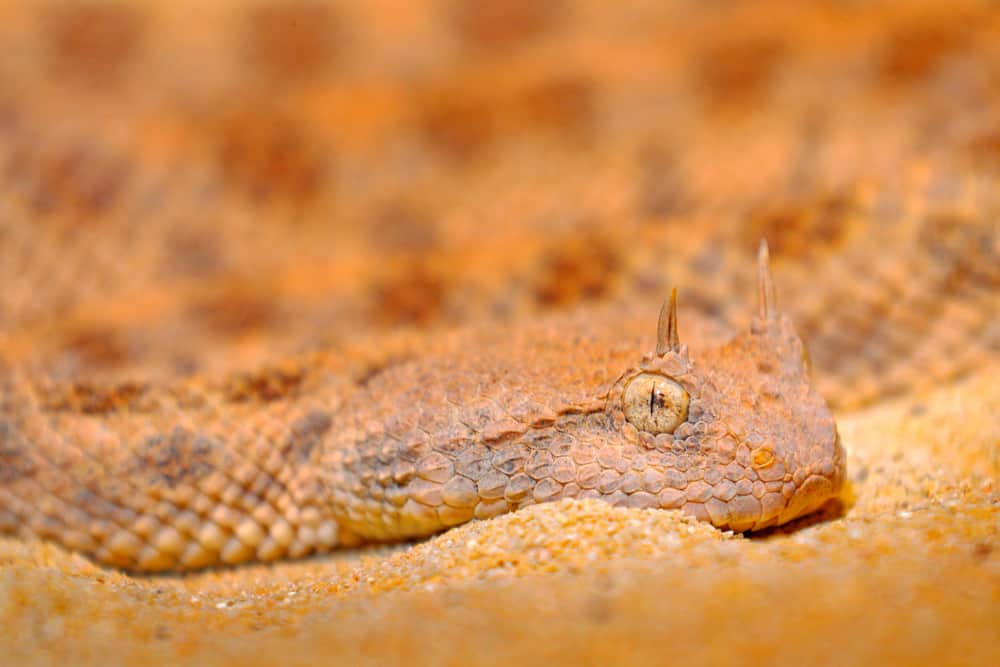
The Desert Horned Viper is small but deadly. At only around 24 inches, this snake is one of the African desert’s most efficient predators.
This species conceals itself beneath the sand and lies in wait for an unsuspecting victim.
Where its range intercepts with those of humans, mishaps can occur. These snakes camouflage themselves well, and people may step on them.
This species is aggressive, has a potent venom, and bites can be painful.
These may not be the best small pet snakes, but some hobbyists love to keep them.
#20 Eastern Tiger Snake (Notechis scutatus)
Origin: Southern Australia
Habitat: Coastal regions, wetlands, and creeks
Level of Aggression: Medium-High
Venom Potency (mg/kg): 0.12 mg
Conservation Status: Least concern
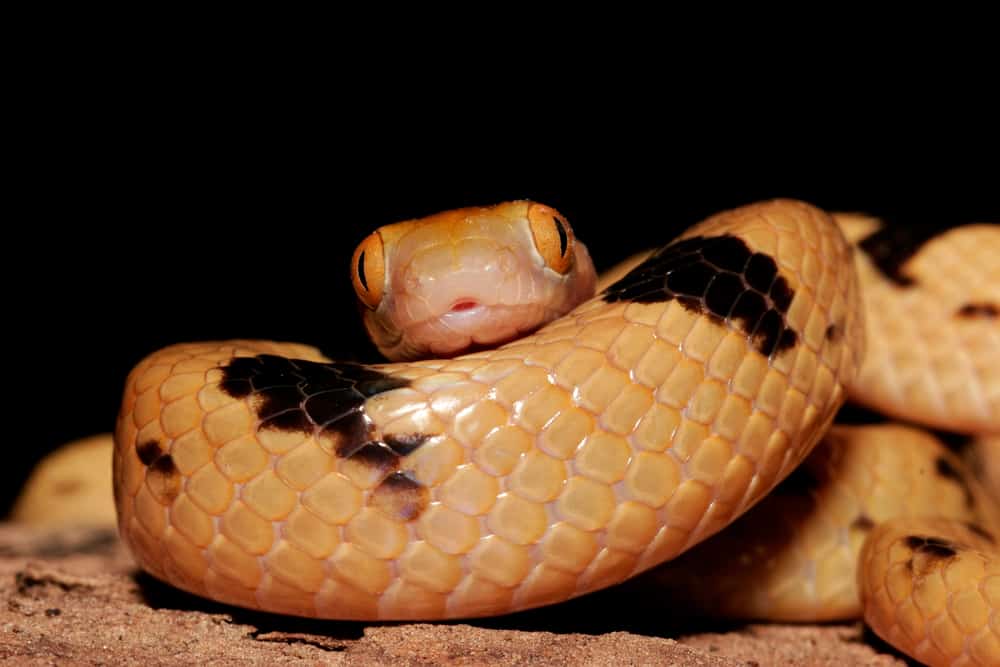
The Eastern Tiger Snake is a calm species that grows to about 3.5 feet. Within its range, it’s common, and it may visit human settlements.
Although its venom is potent, this species is reluctant to bite and tends to retreat. Not every individual has the same bright coloration, and some may be a dull brown with faint barring.
#21 The People Follower – Banded Krait (Bungarus fasciatus)
Origin: Southeast Asia and the Indian subcontinent
Habitat: Diverse; includes forests, farmland, and villages
Level of Aggression: Low
Venom Potency (mg/kg): 1.2 mg/kg
Conservation Status: Least concern
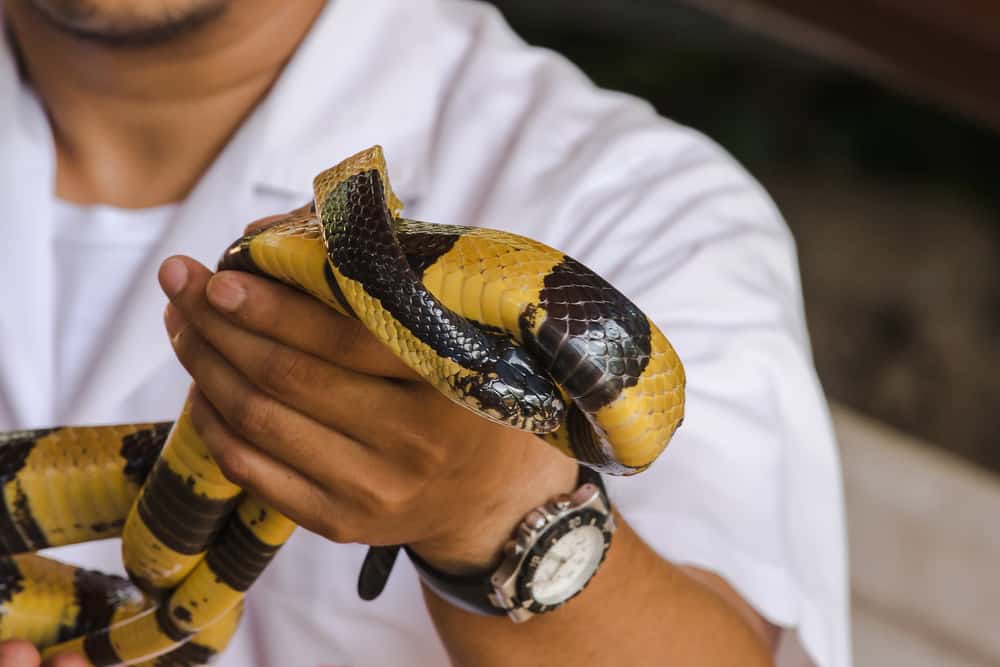
The Banded Krait is a well-known species in Southeast Asia and may move into human settlements.
This closeness to humans means it’s responsible for several bites every year, even if most of them aren’t fatal.
Thanks to its bold coloration, this beautiful species is easy to spot, and you can avoid it. These snakes aren’t aggressive and flee rather than fight.
Where Do the Deadliest Snakes Live?
Most of the world’s deadliest snakes come from three world regions.
The world’s deadliest snake, the Saw-Scaled Viper (Echis carinatus), is a South-East Asian species, and they have a fair share of other culprits.
The Inland Taipan (Oxyuranus microlepidotus), considered by many to be the world’s most venomous snake, is an Australian species.
The Boomslang (Dispholidus typus) and Black Mamba (Dendroaspis polylepis) are two of the world’s most venomous species and only a small percentage of what Sub-Saharan Africa offers.
South-East Asia, Australia, and Sub-Saharan Africa host most of the world’s most venomous snakes.
What’s the Most Venomous Snake in the World?
The Inland Taipan (Oxyuranus microlepidotus), also known as the Fierce Snake or Small-Scaled Snake, is the most venomous snake on the planet.
Everyone doesn’t accept this, and some tests show that the Hook-Nosed Sea Snake (Enhydrina schistosa) produces the most potent venom.
The Taipan produces a far greater venom yield but requires less venom to kill.
What’s the Most Dangerous Snake in the World?
The most dangerous snake in the world is the Saw-Scaled Viper (Echis carinatus).
Most herpetologists agree that the Saw-Scaled Viper causes more deaths than any other snake species.
What’s the Most Venomous Snake in Australia?
While there’s some debate about whether the Taipan is the most venomous snake worldwide, Australia doesn’t have that problem.
Without a doubt, the Inland Taipan (Oxyuranus microlepidotus) is the most venomous snake in Australasia.
The Australian snake with the second-highest venom potency is the Eastern Brown Snake (Pseudechis textilis).
It’s the deadliest snake in Australia and causes 60% of the continent’s snakebite-related deaths.
What’s the Most Venomous Snake in the United States?
The Eastern Diamondback Rattlesnake (Crotalus adamanteus) is the most venomous snake in the US. It takes only 1.5 mg of this species’ venom to kill a full-grown mouse.
A single snake can produce a venom yield of between 200 mg and 850 mg.
The excessive venom, and the snake’s habit of lying in wait where prey can’t see it, make it dangerous. It isn’t just the most venomous snake in the US but the deadliest as well.
Authorities believe that the Eastern Diamondback is the main cause of the five deaths caused by snake bites in the US yearly.
It’s worth noting that scientists attribute most of the 7,000 – 8,000 snake bites recorded in the States every year to the Cottonmouth (Agkistrodon piscivorus).
We hope you’ve enjoyed this article about the most venomous and most deadly snake species in the world. You’ll notice that snakes like the blunthead tree snake didn’t make it onto our list since they’re only mildly venomous.
If you’d like to learn more about snakes in the wild, check out our guide to the snakes of Florida.
But if you’re more interested in pet snakes, consider something like the White Lipped Python or have a look at some of the different colors that Ball Pythons have.
If you have any questions, or you love a venomous snake that wasn’t on this list, please leave a comment below.
